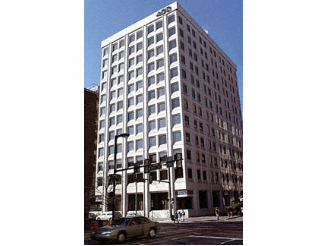Earlier this month, President Obama unveiled the Better Building Initiative (BBI), a public-private partnership that will invest $4 billion toward making federal and commercial office buildings more energy-efficient.
400 Market Street, an 11-story Philadelphia office tower built in 1972, is already serving as a model for how owners of hundreds of older, mid- and high-rise buildings throughout the Northeast and Midwest can reap the benefits of the program.
The 200,000 sf building, home to Philadelphia’s high-powered KWY-AM radio station, was recently renovated with a new HVAC system and a state-of-the-art window retrofitting system called RENOVATE by Berkowitz. According to energy modeling studies conducted with the U.S. Department of Energy’s most sophisticated energy modeling software, a typical 10- to 15-story office building like 400 Market Street could realize significant energy savings.
Developed by J.E. Berkowitz, a glass fabricator based in Pedricktown, N.J., the system works by converting existing single-pane windows into energy-saving, triple-glazed insulating glass units (IGUs) at a cost that is up to 50 percent less than ripping out and replacing old windows with new ones.
The window renovation system also has the benefit of being much faster and less disruptive to install. Berkowitz said the retrofit project for 400 Market Street took about 50 working days, which is two to three times faster than it would have been for a traditional “rip-out-and-replace” project for a similarly sized building. In addition, because the retrofitting was completed indoors, tenants were able to remain in their offices throughout the project. That is not possible with traditional window retrofitting solutions.
The BBI, which was first announced in January 2011, was developed to increase the energy efficiency in commercial buildings by 20 percent by 2020. Under the BBI, 60 private companies, municipal leaders and labor organizers have agreed on a plan to invest $2 billion of private capital to improve commercial, industrial, and manufacturing property. President Obama authorized the government to move forward with another $2 billion in energy-efficiency upgrades to federal buildings, which will be paid for by the long-term savings that the upgrades will provide. BD+C
Related Stories
| Sep 22, 2010
Michael Van Valkenburg Assoc. wins St. Louis Gateway Arch design competition
Landscape architect Michael Van Valkenburgh and a multidisciplinary team of experts in “urban renewal, preservation, commemoration, social connections and ecological restoration” have been picked for the planning phase of The City+The Arch+The River 2015 International Design Competition.
| Sep 22, 2010
Satellier, Potential + Semac close investment deal
Satellier, a world leader in providing CAD and Building Information Modeling (BIM) outsourced services to the architecture, engineering and construction industry, announces a strategic minority investment from India-based top engineering firm Potential + Semac, ushering in the next evolution of the global architecture support industry.
| Sep 21, 2010
New BOMA-Kingsley Report Shows Compression in Utilities and Total Operating Expenses
A new report from the Building Owners and Managers Association (BOMA) International and Kingsley Associates shows that property professionals are trimming building operating expenses to stay competitive in today’s challenging marketplace. The report, which analyzes data from BOMA International’s 2010 Experience Exchange Report® (EER), revealed a $0.09 (1.1 percent) decrease in total operating expenses for U.S. private-sector buildings during 2009.
| Sep 21, 2010
Forecast: Existing buildings to earn 50% of green building certifications
A new report from Pike Research forecasts that by 2020, nearly half the green building certifications will be for existing buildings—accounting for 25 billion sf. The study, “Green Building Certification Programs,” analyzed current market and regulatory conditions related to green building certification programs, and found that green building remain robust during the recession and that certifications for existing buildings are an increasing area of focus.
| Sep 21, 2010
Middough Inc. Celebrates its 60th Anniversary
Middough Inc., a top ranking U.S. architectural, engineering and management services company, announces the celebration of its 60th anniversary, says President and CEO, Ronald R. Ledin, PE.








